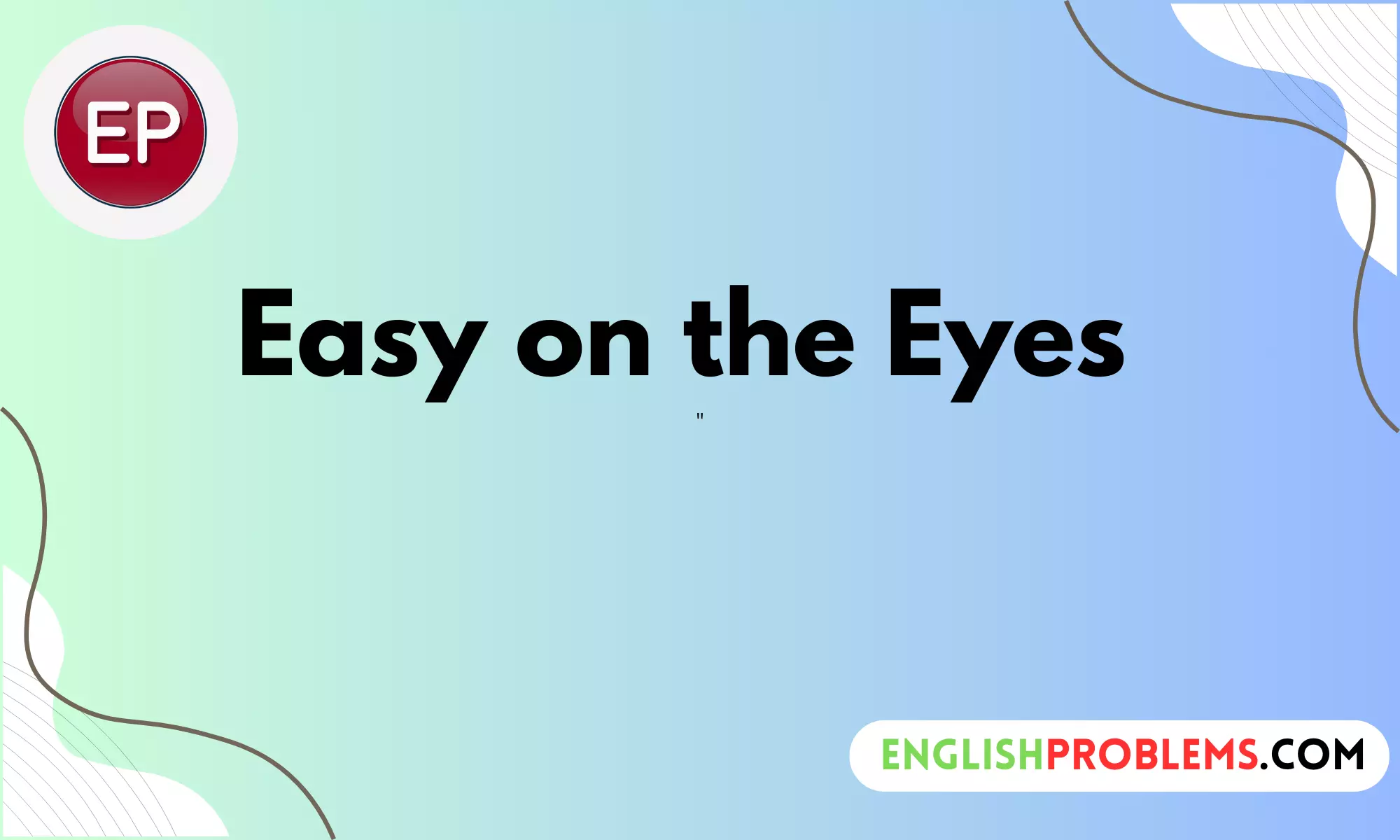Last updated on September 1st, 2024 at 04:42 pm
“Easy on the eyes” is a popular phrase that describes something or someone visually appealing or pleasant to look at. It’s a versatile expression used in various contexts, from personal compliments to design critiques.
In this blog post, we’ll delve deep into the meaning of the phrase, provide rich examples, explore its usage, and offer practical tips on employing this expression effectively.
Meaning of “Easy on the Eyes”
Literal Meaning
At its core, “easy on the eyes” refers to something that is not harsh or uncomfortable to look at. This literal interpretation implies that the visual aspect is soothing or agreeable. For example, a well-designed website with soft colors and intuitive navigation is easy on the eyes because it doesn’t strain or overwhelm the viewer.
Figurative Meaning
Figuratively, “easy on the eyes” is used to describe something or someone that is aesthetically pleasing. This can apply to a variety of contexts:
- People: When describing someone as easy on the eyes, you’re often referring to their physical attractiveness in a subtle, non-objectifying manner. This could be about a person’s facial features, style, or overall presence.
- Design Elements: In the context of design, this phrase can refer to elements that are visually appealing, such as a clean layout or a harmonious color scheme.
- Scenery: It can also apply to natural landscapes or well-maintained environments that offer a pleasing visual experience.
Contextual Nuances
The phrase “easy on the eyes” can vary in meaning depending on context. For instance, a person might be described as easy on the eyes if they have a charming smile or a stylish appearance. Conversely, a product or design that is easy on the eyes would be visually attractive without being overwhelming or garish.
Examples of “Easy on the Eyes”
People
- Celebrity Examples: Celebrities often receive compliments that they are “easy on the eyes.” For instance, actors like Ryan Gosling or Emma Watson are frequently described in this way due to their conventional and appealing features. Their looks are considered visually pleasing in a manner that is universally acceptable.
- Everyday Individuals: Someone who maintains a polished appearance or has a naturally pleasant demeanor might be described as easy on the eyes. For example, a well-dressed individual at a formal event or a friend who always seems to exude charm might receive this compliment.
Design
- User-Friendly Websites: Websites like Apple or Airbnb are known for their sleek and user-friendly designs. The visual appeal of their interfaces, characterized by clean lines and subtle color palettes, makes them easy on the eyes.
- Product Packaging: Coca-Cola’s classic red and white packaging is another example. The design is not only recognizable but also visually pleasing due to its simplicity and effective use of color.
Scenery
- Natural Landscapes: A serene beach scene or a picturesque mountain view can be described as easy on the eyes. These settings offer natural beauty that provides a calming and enjoyable visual experience.
- Urban Green Spaces: Parks like Central Park in New York offer a blend of natural beauty and well-maintained landscapes that are easy on the eyes. These spaces provide a visual retreat from the hustle and bustle of urban life.
Usage of “Easy on the Eyes”
Common Contexts
- Personal Descriptions: When used to compliment someone, the phrase can serve as a polite and respectful way to acknowledge their attractiveness. For instance, saying “You look great today; you’re really easy on the eyes” is a friendly and positive remark.
- Design and Media: In reviews and critiques, describing something as easy on the eyes often highlights its aesthetic quality. For example, a designer might use this phrase to praise a well-executed marketing campaign or product design.
Tone and Connotation
- Positive Implications: Generally, the phrase carries a positive connotation, suggesting that something is visually pleasing or attractive. It’s often used in a flattering context and implies appreciation for the visual qualities being described.
- Neutral to Subjective: While the phrase is usually positive, its reception can be subjective. What one person finds easy on the eyes, another might not. Therefore, it’s important to consider the preferences of the audience or individual being described.
Variations and Related Expressions
Similar Phrases
- Pleasing to the Eye: This phrase is often used interchangeably with “easy on the eyes” and conveys a similar meaning of visual appeal.
- Visually Appealing: This term is commonly used in design and art to describe something that is aesthetically attractive.
- Attractive: While broader in scope, this term also conveys the idea of visual appeal but can apply to more contexts beyond just appearance.
Contrasts
- Harsh on the Eyes: This phrase is used to describe something visually unpleasant or straining. For example, a website with a cluttered design and glaring colors might be considered harsh on the eyes.
- Unappealing: This term is a more direct way to describe something that lacks visual attractiveness or is aesthetically displeasing.
Practical Tips for Using the Phrase
Appropriate Usage
- Formal vs. Informal Settings: Use “easy on the eyes” in informal settings when complimenting someone’s appearance or discussing design elements. In formal contexts, consider using more specific descriptors or adjectives that align with the setting.
- Context Sensitivity: Tailor your use of the phrase based on context. For instance, in professional design reviews, focus on how design elements contribute to a visually pleasing experience.
Avoiding Overuse
- Vary Your Language: To avoid repetition, use synonyms or related expressions. For example, instead of repeatedly saying something is “easy on the eyes,” you might describe it as “visually pleasing” or “aesthetically attractive.”
- Be Genuine: Ensure that your compliments or observations are sincere. Overusing flattering phrases can come across as insincere or formulaic.
Conclusion
In summary, “easy on the eyes” is a versatile phrase that conveys visual appeal in a pleasant and flattering manner. Whether describing people, design, or scenery, understanding its meaning and usage can enhance your ability to communicate effectively and appreciatively. By using this phrase thoughtfully and considering its context, you can enrich your language and express your observations more meaningfully.

Lucy Wright combines her academic background with a flair for simplifying the intricate details of grammar. Her practical advice and clear explanations empower readers to improve their writing skills and grasp challenging concepts effortlessly.










